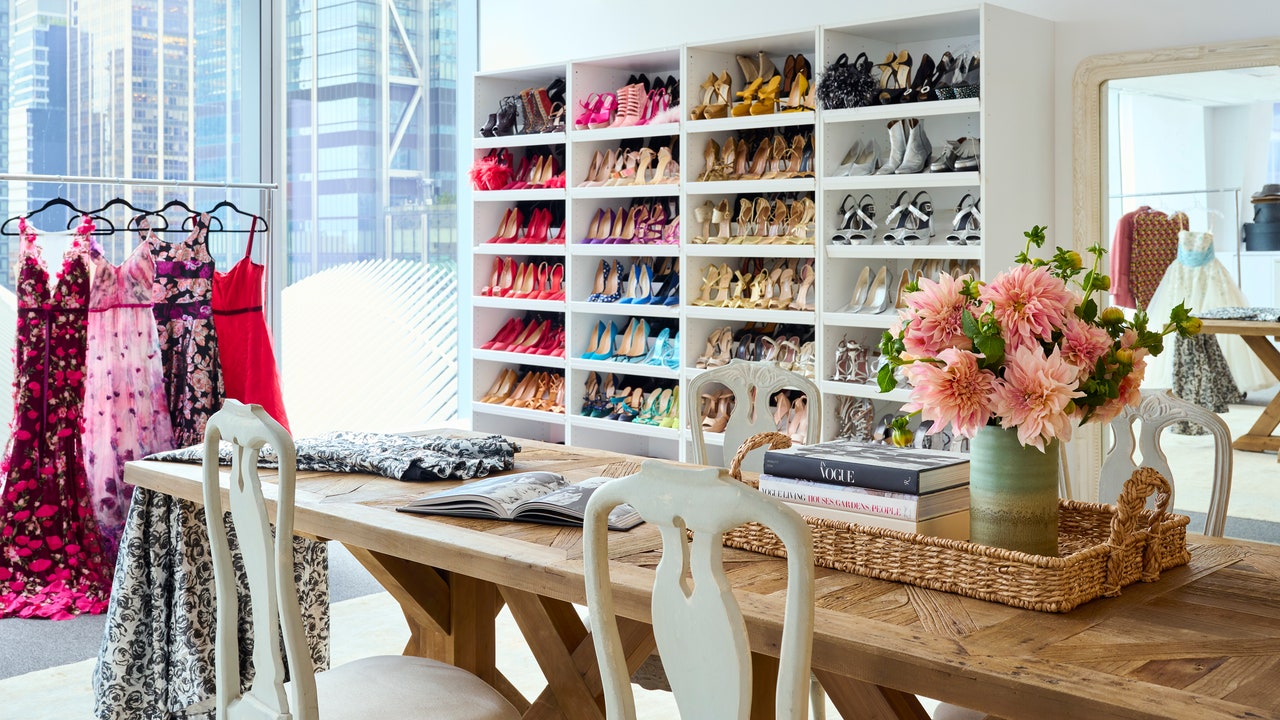Condé Nast Has the Ultimate Fashion Closet—Here’s What You Can Learn From Its Creators – Architectural Digest

The space also feature a kilim-covered sofa by George Smith and a rug by Loloi.
Photo: Kyle Knodell
Practicality is of course paramount, particularly in the closet itself, which is organized into discrete zones so that all items are easy to find and access. Pairs of shoes are displayed across one wall, while accessory-filled cabinets are installed along another. A conference table in the center can facilitate any meetings, interviews, or events that might take place in the space, and can be wheeled away on casters if necessary. Low-pile carpets prevent rolling garment racks or stiletto heels from getting caught.
A linen-upholstered Four Hands chaise flanks a back wall in the second dressing room, along with pillows in Rose Tarlow and Pierre Frey fabrics. The mirror is from Uttermost, and the artwork is from Carrier and Company’s collection for Soicher Marin.
Photo: Kyle Knodell
In the dressing rooms, Carrier and Miller had the opportunity to be more playful with the decor. One space features hues of pink, orange, and red across floral-patterned wallpaper, sofa upholstery, and a large area rug—some of them sourced from Carrier and Company’s licensing partnerships—while the other has cooler tones and a more restrained aesthetic. Carrier highlighted the need for these rooms to be spacious and largely uncluttered, given the scale and delicate nature of the haute-couture gowns often worn in there. “This isn’t just a dressing room where you’re trying on a pair of jeans and a blouse,” he says. “Oftentimes, these are costumes that might take a couple of people to help get into.”
Although not everyone is lucky enough to enjoy access to the space and the contents of the Condé Nast Fashion Closet, that doesn’t mean others don’t deserve the same level of design “star treatment.” So Carrier has shared his tips for designing and organizing the perfect closet.
The second dressing room takes a quieter approach. There, the designers installed striped Carrier and Company for Lee Jofa wallpaper and curtains.
Photo: Kyle Knodell
An English mahogany foot stool sourced at Montage Antiques offers a perch in the fitting room.
Photo: Kyle Knodell
1. Divide and conquer
One of his top suggestions is to separate and present smaller accessories and jewelry using drawer dividers, preferably in luxurious materials. “Look at your collection, whether it is jewelry, watches, ties, or baseball caps, and outfit your drawers with these wonderful little compartments so that things are clearly and beautifully organized. These might be cashmere wrapped, they might be leather lined,” he says, adding that The Container Store is also a solid option for those on a budget.
2. Use extra space to your advantage
“If you have the luxury of space and a bit of room to spare, add a small table with a bowl full of flowers, or a comfortable chair in the corner so that you can sit down to put your shoes on, or plop your bags on as you come in. It just helps to make the space more livable, approachable, and comfortable.”
3. Balance practical and pretty storage
“It’s always a bit of a balance of pretty storage and functional storage. It’s more visually pleasing if you can add softer elements like wicker baskets or fabric-wrapped boxes that help to soften the millwork. Yes, there are certainly important organizational components that are useful, but I think you can have the best of both.”
4. Take cues from luxury retailers of the past
“You used to be able to go to department stores where the dressing rooms were beautiful spaces. In this day and age, when so many things are just shipped to order and they arrive in a box at your door, having the ability to take a moment and create an environment within your dressing area—whether it’s a walk-in closet or a corner of your bedroom—that makes more of an experience out of the act of dressing is something I think people are missing.”
5. Treat the closet as part of the home
“Really treat it as an extension of your interior, with hopes of it being about an experience and not just the utility.” This can be achieved through the continuation of flooring, paint color, wallpaper, or matching the millwork to other rooms. He also encourages the use of wallpapers, area rugs, and artwork to offer decorative touches. “Some people like their closet to just be organized and white, so they’re not distracted. But in addition to the functionality, it can be playful, it can be beautiful, it can be romantic, it can be a fantasy.”
Copyright :

